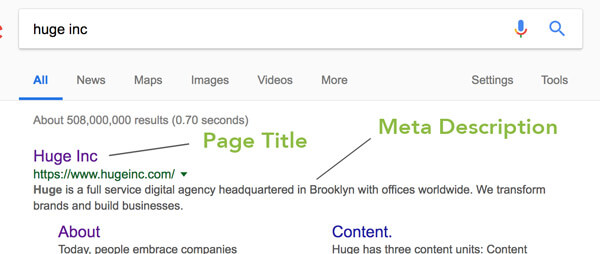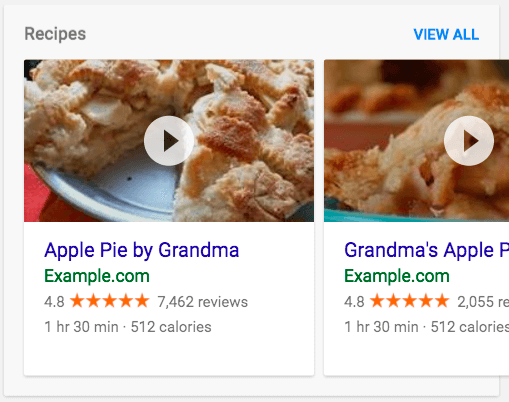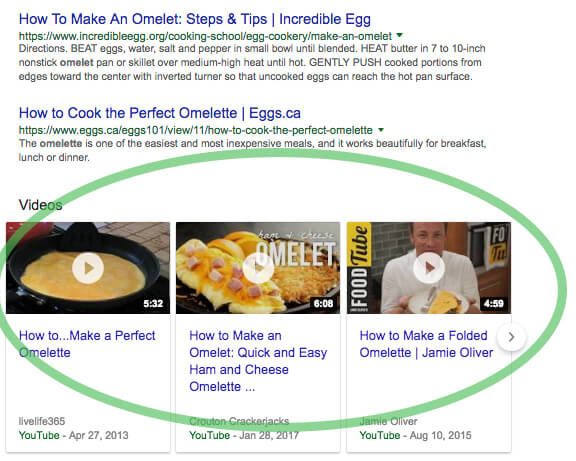If you read my article on Google RankBrain tips, you know the SEO game is changing rapidly.
Google’s getting smart. Search engines are learning more and more about what makes their users like you and I happy.
Google has decided that we know best, so every time you or I do a search, our behaviour and data is being taken into account in their algorithm.
Those behaviour cues are used to judge how good a fit the search results were.
What’s the bottom line?
The traditional SEO rules you’ve come to learn over the last decade need a serious do-over.
Let me walk you through 9 new rules:
- Google searches for your brand: the new backlinks
- Increase your click-through-rate (CTR)
- Create links to websites of authority
- Optimize for voice search
- Reduce your bounce rate
- Use video to supplement your posts
- Improve your page load times
- Determine what’s important for your industry
- Write good content
Google searches for your brand: the new backlinks
If you’ve ever searched for how to get more visitors on your website, then you know backlinks are super important for SEO. When a website like nytimes.com links to your site, this signals that you’ve got some street cred, and search engines are going to rank you a lot better.
RankBrain no longer just relies on other sites backlinking to you in order to know that you have quality content.
Google now looks at its users’s searches to determine what brands are noteworthy. If a ton of people are searching for your brand, then you’re probably relevant. That’s why content marketing has become so effective.

Online marketing expert Neil Patel found this SEO hack accidentally. He was actually doing an Instagram marketing experiment.
He had Instagram influencers post messages where they were holding up signs “Who is Neil Patel”

While this helped rapidly grow his (now defunct) Instagram channel @whoisneilpatel, he found some curious other side effects.
Of course, at first he first noticed he got a ton of new Google searches for him in March. People were trying to find out who he was, as intended by the campaign. At that time he was getting 195,596 monthly visitors.
But then his monthly visitors started to sky rocket. By June he was getting 240,839 monthly visitors, and by August it was at a staggering 454,382 monthly visitors.
That is an increase in traffic by over 232% from February, when he started his campaign.
If you listen to what Google has said, this actually shouldn’t come as a surprise.
Eric Schmidt, Ex CEO @ Google said:
The fundamental way to increase your rank is to increase your relevance.
Meaning, you can do all the SEO tricks you want, but at the end of the day, Google knows if people are actually searching for you, and if you’re actually relevant.
Schmidt went on to say:
Brands are the solution, not the problem. Brands are how you sort out the cesspool.
What does this mean for you?
It means that you want to increase your exposure at every opportunity.
You might not have the budget or desire for Instagram models to be holding up signs with your brand name. Luckily, there are a lot of other great ways to increase your relevancy. You just need to brainstorm what fits for your business.
I had a friend who started an online clothing business. She decided at one point to put decals on her vehicle with her brand name. When she went into Google analytics, she noticed she was typically getting 20-40 searches a day for her brand. Before putting up the decals, she was getting near 0. She’d see that the new searches would pop up in whatever city she was visiting.

Decals might not work for you, but find something that would. A start could be as simple as putting stickers around town, a contest in bulletin boards, business cards around town at cafes, and so on.
Know where your target audience hangs out, and provide value, or invoke some intrigue. That way they’ll be searching for you.
What else?
You could do a guest appearance on a local podcast (there are lots for virtually all major cities across North America). There are also a ton of industry specific podcasts. Or do like one of my clients and start your own.
Another way to increase your exposure, is to do a talk at a Meet Up, or at any type of networking event.
At the very least, you should be using all your social media platforms.
Besides the usual return on these types of marketing, getting your brand out there has now become way more valuable as an SEO trick for getting your company in a digital space.
Increase your click-through-rate (CTR)
When people click on your page in the Google search results, this is a good signal to Google.
That means, at the very least, you should make sure that you have great writing in your page title, and meta description.

If you have a WordPress site, get a plugin such as All In One SEO or Yoast. They’ll make it easy for you to update these, and tell you the right amount of characters to use.
I have a few tips for optimizing these.
If you have a blog like we do, then make sure a lot of your articles are numbered. 11 Things to Know When Getting Your First Mortgage. 8 Tricks To Lowering Your Dental Bills. You get the point.
It signals to the reader that your article is in digestible little pieces, which fits well with how users user the web – by scanning.
If there are some main article keywords, try to get it in both title and description.
Another big tip: use structured data.
These are things like reviews, calories, location, etc.
This will increase the real estate of your page in the search results:

Many companies have seen their CTR’s raised, some by 28% by using structured data.
If you have a WordPress website use a structured data plugin or have us do it for you.
Of course, hooking in with tip #1 – the higher your brand awareness, the higher your CTR will be. That is why doing paid advertisements for your brand can have great impacts on your organic content as well.
Create links to websites of authority
This recent study found that by linking to relevant, authoritative pages, you can get a boost in Google.
It makes perfect sense. If you link to high quality sources, then it’s likely a reflection of your article.

What makes for a “good site”? Check out Moz’s tool to determine page and domain authority.
Set a goal for each of your blog articles and ensure you’re linking to at least 3-5 high quality and relevant websites.
Optimize for voice search
Let’s look at the numbers.
41% of adults, and 55% of teens use voice search daily.
In 2016, 20% of Google mobile searches were voice searches.
It’s not just mobile though – 25% of Windows 10 searches were made by voice
Voice search has been on an upward trajectory with the huge developments made by digital assistants such as Siri and Google Assistant.
Voice searches are quicker and often more convenient than typing out a search. For example, when I’m cooking or doing chores, I like to pester Google Home with a million questions.

Bottom line?
Try structuring some of your content in more of a conversational tone.
Why?
Voice searches tend to be much more conversational. In fact, Google says about 70% of these searches are conversational.
Let’s say we were searching for how to brew beer.
Between “How to brew beer” and “How do I brew beer in my home?”, which one do you think was made by voice, and which one do you think was typed out?
Keep that in mind when writing. Be ahead of the curb – you’re going to have an easier time dominating voice searches before everyone else catches up.
For more details on how to optimize for voice searches, read up on this article by Backlinko.
Reduce your bounce rate
“Nowadays, in order for a site to rank organically, Google needs proof human beings actually like what they click on.” – SEM Rush
What is bounce rate?
It’s the percentage of people who leave your site after only one page visit.
A bounce rate of 20% means that only 20% of people left your site without visiting any other pages than the first one.
It’s one of the most important factors for Google RankBrain.
How do I reduce it?
There’s a few quick and easy ways.
A big one is to use bucket brigading.
What’s that?
It’s basically writing small cliffhangers in your content. It’ll stop people from dropping off.
Here’s a few used by Omar Nowaz:
- Here’s the deal:
- Now:
- What’s the bottom line?
- This is crazy:
- But here’s the kicker:
Use these bucket brigades throughout your content, to keep your readers intrigued and engaged.
What else?
Make sure to cross pollinate your content at every opportunity. Make good use of internal linking.
Always have some sort of post or product navigation.

Related or relevant content are typically better than just the most recent, people will be more likely to click since they’ve been prequalified for that category.
Last one is big:
Clean up your navigation. Users can’t effectively handle more than 6-7 items in their working memory.
Take it from UX expert Alita Joyce:
“Excessive product or service offerings can make it impossible for users to make a decision. Alternatively, too many options can also cause users to hastily make a decision and later regret their choice.”
Use video to supplement your posts
You’ve heard it a million times: video is the best content for web.
So why are you not using it consistently?
When you use a video, you’ll not only see a lot more engagement on social media and blog posts. You’ll also be able to find a lot more of your audience.
Don’t forget, Youtube is the second most popular search engine.
Even more reason to use video? Google displays Youtube results in its own search engine.

One of my clients shoots his videos in batch, one morning every few months. Then he posts once a week. He’ll make a blog post for the video, with a text transcript, or an even more involved article below the video.
This strategy, leveraging both video and text, allows for a much better user experience, as users will pick whatever medium fits them best. You’ll also get keywords on the page, covering all your SEO bases.
Don’t forget, Google is tracking how long users spend on your page. Engage them with video, and they’ll be on your site for a lot longer.
Improve your page load time
This is a big one:
First off, improving your page speed will reduce bounce rate (see point 5)
A one second delay was found to reduce conversions by 7% by Strange Loop.
“Google Search found that a 400 millisecond delay resulted in a -0.59% change in searches/user.” – Radar
But wait.
As of last month, Google now uses page speed in its algorithm for mobile search results.

How do I improve my page speed?
First get a grasp on how well you’re doing. PageSpeed Insights is a great tool. They also provide recommendations.
Make sure you’re optimizing and compressing your images, through tools like Tiny PNG.
If you’re on WordPress, leverage a cacheing plugin, and make sure you’re also on a Content Delivery Network (CDN) such as Cloudflare.
If you’d like us to give us a complimentary review in how well you’re doing, get in touch.
Determine what works in your industry
Don’t think that there is one master Google algorithm. Because it looks like there is not.
Rand from Moz found that RankBrain seems to be treating different industries in unique ways.
Which makes sense. Things like goals and intentions can vary drastically in different groups of people.
Make sure to always do a competitive analysis, and see what is popular in your industry. One of the best tools for finding what is popular based on social engagements is Buzzsumo. You can see number of engagements, meaning you have real data to determine popularity.

Besides seeing what topics are popular in your industry, you can see what the biggest players are doing, and emulate what they are doing well.
Write good content
Duh.
But wait a minute.
Have you actually reviewed what makes good web content?
Most of us are experienced writing essays in high school and maybe even papers in university.
But writing for web has many different rules.
Keep sentences and paragraphs short, like this one.
Don’t be afraid to use a conversational style, it’s more engaging.
Don’t use fluff to reach a certain word count, people will drop off, and Google will notice.
Most university students are familiar with the dreaded word count. Professor requires 10,000 words, so you end up repeating yourself.
For modern day web, that is a no-no. There are some recommendations for word count – Hubspot found their special number to be 2500. But use that as more of a guideline, and don’t sacrifice quality for quantity.
At the end of the day, writing good content will impact the rest of the earlier points. Make sure you are well versed in good web writing practises, and adapt your blog writing accordingly.
Conclusion
With search engines getting smarter, there are becoming less ways to trick them.
Long gone are the days of putting white text in a white background.
Stop thinking of SEO as hacks used to fool search engines, and you will see the results.
Google and others like Bing are using real user indicators of how satisfied users are. This means that content now needs to be of high value to be competitive. Keyword stuffing is on its way out the door.
RankBrain understands that keywords come in concepts and groups, and this means you can worry less on keyword counts, and more on value to your website visitors.
Between competitive analysis and staying engaged with your target audience, figure out what your audience needs and you will reap the benefits.















